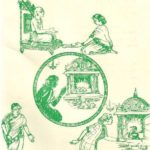Sri Ramanuja Munaye Namaha,
Sri Velukkudi Krishnan Swami Guruve Namaha,
Dear Bhagavata,
Adiyen will share similar reference from Sri Velukkudi Krishnan Swami’s upanyasam for this context as well with Acharya Krupai and Swami’s Arul.
The BASE grammer for sanskrit is called “Paanini Soothram” which was written by “Paanini Maharishi” which is common for any Matham like Srivaishavism (Advaitam, Dvaitham, Vishitaadvaitam) or Saivism or Gaanapathyam or Koumaram or Boudham etc….
Using this base sanskrit grammar, gurus of these faiths write the philosophy in sanskrit referring to Shastras AS IT IS and some gurus interpret Shastras in their own way based on their level of understanding, so different faiths exists using same base sanskrit grammer written by Paanini.
So getting in to answering BhagavAtas question, some Background needs to be understood as below.
****************************
Background:
Overall Paanini Soothram has two classifications:
a) Roodi Artham (रूढि) means “Etimology” (breakdown of each sanskrit words combined together should have a meaning),
b) Loukika Artham (लौकिक) means “Popular Usage” (Popularly usage meaning of the word in routine life).
Example used by Acharyas to establish Sriman NarayanA as the “ParamAthma” as per Shastras and NOT Shiva is by using the same Paanini sanskrit grammar common between Srivaishnavism and Saivism, where both Roodi and Loukika As then should match to one person only.
a) Etimology meaning (Roodi Artham):
NA RA YA NA “நா ரா ய ண” split in to two
“NARA” Kootal “AYANAM” –> நார + அயனம் == நாராயண.
‘NARA (நார)‘ means Narangal (நாரர்கள்), means all JeevAthmas, Sentient.
‘AYANAM (அயனம்)‘ means where the Narargal (நாரர்கள்) reside.
‘kootal’ in tamil means ‘+’ addtion.
So, when NARA (நார) and AYANAM (அயனம்) is combined then,
ர + அ = ரா, so ‘நாரா”
and the ‘moonu suzhi ‘NA (ண)’ instead of oru suzhi ‘NA (ன) is added as per grammer.
and hence, நார + அயனம் =நாராயண. ‘NARAYANA, which means means “the resort or place where the ‘Narargal ‘All Jeevas’ (நார)‘ Reside (அயனம்) ‘” is ‘NARAYANA (நாராயண).
b) Popular Usage meaning (Loukika Artham):
In popluar usage, when soemone says BhagavAN Narayana, it is immediately understood, that BhagavAn Sriman Narayananan is teh one we are talking about.
==========
So, by ‘Etimology’ it is understood all JeevaAthmas reside on Narayana and by ‘Popular Usage’ it is understood that Narayana word is used to call BhagavAn Narayana, whose other Poorna avatarams (appearance chance without change in kalyana gunas) are Perumal, SriKrishna, SriRama etc…
============
When breaking down the meaning (Good I As then) for the Word “Shiva”, it doesn’t represent all Narargal reside (Gyanam) on that person, but the “Popular usage (Loukika artham)” refer to the Shiva demi-god. So Shiva is Not termed as ParamAthma as per the common Paanini grammar between Srivaishnavism and Saivism, roodi as then doesnt reflect the NARAYANA breakdown meaning.
=============
Same scenario applies to common people or false gurus, example if one has name as NarayAna, then ‘Popular and Etimology’ meaning refers the actual BhagavAn NarayanA in deity forms or other forms, so we are not NarayanA, and we are JeevAthma has just same name as NarayanA.
================
Now going back to the question, same rule applies.
The Roodi Atham (Etimology) for
- Smartan (belonging to Smriti)
- Srouti (belonging to Sruti)
- Sastri (expert in Sastram)
- Ghanapaathi (expert in Ghana paatham of vedam),
All applies to any Brahmana of any faith who follows it.
Coming back to the Loukika Artham (Popular usage), it immediately refers to Advaitham because, before Sankaracharyas’ birth, the “Veda Bahyargal (one who doesn’t follow Vedas)” Matham’s were flourishing, so Sanjaracharyas first assignment was to establish Veda Maargam by following Shruthi, Smriti etc….. And Sriman NarayanAn as ParamAthma as per Vedas. Due to Sankaracharyas busy assignment and His life span was short, He couldn’t further reveal the Vedas about Chit, Achit & ParamAthma, so He focussed only on “Abedha Shruthi (non-dualism)“. So keeping Advaitam as Base, Swami Ramanujar revealed the Three Tatvams as per “Kataka Shruthi (Dualism)” as “Vishista-Advaitam”.
That’s why using these words smartan etc… refers to “popular usage’ advaitam as advaitam was first of its kind to reestablish Veda Maargam, though ‘etimology’ meaning applies to all who follows it.
Adiyen Sri Velukkudi Krishna Dasan,
Uyya Oraey Vazhi UdayavAr ThiruvAdi,
Sarvam SriKrishnarpanam Asthu


